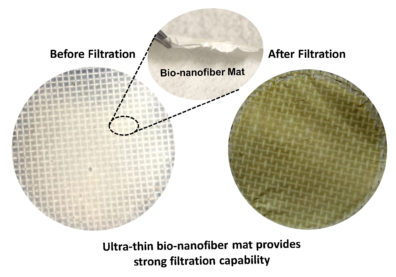I love the fact that ‘frozen smoke’ is another term for aerogel (which has multiple alternative terms) and the latest work on this interesting material is from the University of Cambridge (UK) according to a February 9, 2023 news item on ScienceDaily,
Researchers have developed a sensor made from ‘frozen smoke’ that uses artificial intelligence techniques to detect formaldehyde in real time at concentrations as low as eight parts per billion, far beyond the sensitivity of most indoor air quality sensors.
The researchers, from the University of Cambridge, developed sensors made from highly porous materials known as aerogels. By precisely engineering the shape of the holes in the aerogels, the sensors were able to detect the fingerprint of formaldehyde, a common indoor air pollutant, at room temperature.
The proof-of-concept sensors, which require minimal power, could be adapted to detect a wide range of hazardous gases, and could also be miniaturised for wearable and healthcare applications. The results are reported in the journal Science Advances.
…
A February 9, 2024 University of Cambridge press release (also on EurekAlert), which originated the news item, describes the problem and the proposed solution in more detail, Note: Links have been removed,
…
Volatile organic compounds (VOCs) are a major source of indoor air pollution, causing watery eyes, burning in the eyes and throat, and difficulty breathing at elevated levels. High concentrations can trigger attacks in people with asthma, and prolonged exposure may cause certain cancers.
Formaldehyde is a common VOC and is emitted by household items including pressed wood products (such as MDF), wallpapers and paints, and some synthetic fabrics. For the most part, the levels of formaldehyde emitted by these items are low, but levels can build up over time, especially in garages where paints and other formaldehyde-emitting products are more likely to be stored.
According to a 2019 report from the campaign group Clean Air Day, a fifth of households in the UK showed notable concentrations of formaldehyde, with 13% of residences surpassing the recommended limit set by the World Health Organization (WHO).
“VOCs such as formaldehyde can lead to serious health problems with prolonged exposure even at low concentrations, but current sensors don’t have the sensitivity or selectivity to distinguish between VOCs that have different impacts on health,” said Professor Tawfique Hasan from the Cambridge Graphene Centre, who led the research.
“We wanted to develop a sensor that is small and doesn’t use much power, but can selectively detect formaldehyde at low concentrations,” said Zhuo Chen, the paper’s first author.
The researchers based their sensors on aerogels: ultra-light materials sometimes referred to as ‘liquid smoke’, since they are more than 99% air by volume. The open structure of aerogels allows gases to easily move in and out. By precisely engineering the shape, or morphology, of the holes, the aerogels can act as highly effective sensors.
Working with colleagues at Warwick University, the Cambridge researchers optimised the composition and structure of the aerogels to increase their sensitivity to formaldehyde, making them into filaments about three times the width of a human hair. The researchers 3D printed lines of a paste made from graphene, a two-dimensional form of carbon, and then freeze-dried the graphene paste to form the holes in the final aerogel structure. The aerogels also incorporate tiny semiconductors known as quantum dots.
The sensors they developed were able to detect formaldehyde at concentrations as low as eight parts per billion, which is 0.4 percent of the level deemed safe in UK workplaces. The sensors also work at room temperature, consuming very low power.
“Traditional gas sensors need to be heated up, but because of the way we’ve engineered the materials, our sensors work incredibly well at room temperature, so they use between 10 and 100 times less power than other sensors,” said Chen.
To improve selectivity, the researchers then incorporated machine learning algorithms into the sensors. The algorithms were trained to detect the ‘fingerprint’ of different gases, so that the sensor was able to distinguish the fingerprint of formaldehyde from other VOCs.
“Existing VOC detectors are blunt instruments – you only get one number for the overall concentration in the air,” said Hasan. “By building a sensor that is able to detect specific VOCs at very low concentrations in real time, it can give home and business owners a more accurate picture of air quality and any potential health risks.”
The researchers say that the same technique could be used to develop sensors to detect other VOCs. In theory, a device the size of a standard household carbon monoxide detector could incorporate multiple different sensors within it, providing real-time information about a range of different hazardous gases. The team at Warwick are developing a low-cost multi-sensor platform that will incorporate these new aerogel materials and, coupled with AI algorithms, detect different VOCs.
“By using highly porous materials as the sensing element, we’re opening up whole new ways of detecting hazardous materials in our environment,” said Chen.
The research was supported in part by the Henry Royce Institute, and the Engineering and Physical Sciences Research Council (EPSRC), part of UK Research and Innovation (UKRI). Tawfique Hasan is a Fellow of Churchill College, Cambridge.
Here’s a link to and a citation for the paper,
Real-time, noise and drift resilient formaldehyde sensing at room temperature with aerogel filaments by Zhuo Chen, Binghan Zhou, Mingfei Xiao, Tynee Bhowmick, Padmanathan Karthick Kannan, Luigi G. Occhipinti, Julian William Gardner, and Tawfique Hasan. Science Advances 9 Feb 2024 Vol 10, Issue 6 DOI: 10.1126/sciadv.adk6856
This paper is open access.
